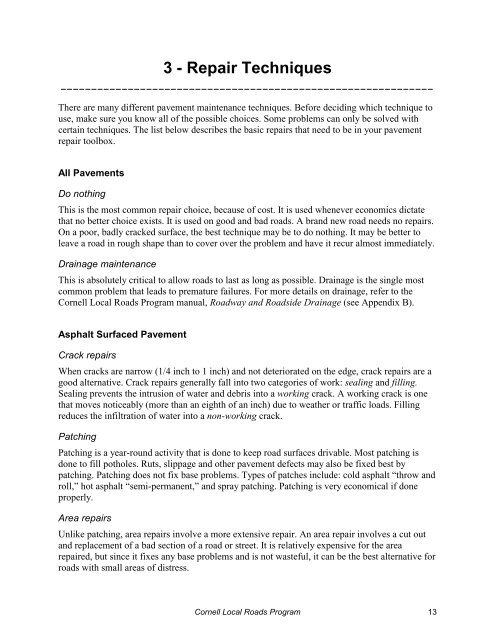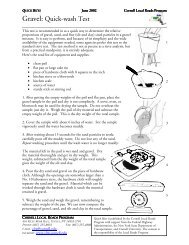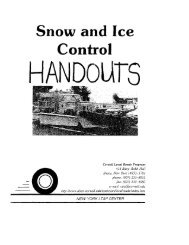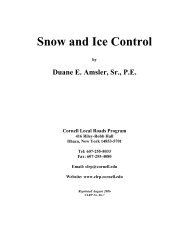Pavement Maintenance - Cornell Local Roads Program - Cornell ...
Pavement Maintenance - Cornell Local Roads Program - Cornell ...
Pavement Maintenance - Cornell Local Roads Program - Cornell ...
You also want an ePaper? Increase the reach of your titles
YUMPU automatically turns print PDFs into web optimized ePapers that Google loves.
3 - Repair Techniques<br />
_____________________________________________________________<br />
There are many different pavement maintenance techniques. Before deciding which technique to<br />
use, make sure you know all of the possible choices. Some problems can only be solved with<br />
certain techniques. The list below describes the basic repairs that need to be in your pavement<br />
repair toolbox.<br />
All <strong>Pavement</strong>s<br />
Do nothing<br />
This is the most common repair choice, because of cost. It is used whenever economics dictate<br />
that no better choice exists. It is used on good and bad roads. A brand new road needs no repairs.<br />
On a poor, badly cracked surface, the best technique may be to do nothing. It may be better to<br />
leave a road in rough shape than to cover over the problem and have it recur almost immediately.<br />
Drainage maintenance<br />
This is absolutely critical to allow roads to last as long as possible. Drainage is the single most<br />
common problem that leads to premature failures. For more details on drainage, refer to the<br />
<strong>Cornell</strong> <strong>Local</strong> <strong>Roads</strong> <strong>Program</strong> manual, Roadway and <strong>Roads</strong>ide Drainage (see Appendix B).<br />
Asphalt Surfaced <strong>Pavement</strong><br />
Crack repairs<br />
When cracks are narrow (1/4 inch to 1 inch) and not deteriorated on the edge, crack repairs are a<br />
good alternative. Crack repairs generally fall into two categories of work: sealing and filling.<br />
Sealing prevents the intrusion of water and debris into a working crack. A working crack is one<br />
that moves noticeably (more than an eighth of an inch) due to weather or traffic loads. Filling<br />
reduces the infiltration of water into a non-working crack.<br />
Patching<br />
Patching is a year-round activity that is done to keep road surfaces drivable. Most patching is<br />
done to fill potholes. Ruts, slippage and other pavement defects may also be fixed best by<br />
patching. Patching does not fix base problems. Types of patches include: cold asphalt “throw and<br />
roll,” hot asphalt “semi-permanent,” and spray patching. Patching is very economical if done<br />
properly.<br />
Area repairs<br />
Unlike patching, area repairs involve a more extensive repair. An area repair involves a cut out<br />
and replacement of a bad section of a road or street. It is relatively expensive for the area<br />
repaired, but since it fixes any base problems and is not wasteful, it can be the best alternative for<br />
roads with small areas of distress.<br />
<strong>Cornell</strong> <strong>Local</strong> <strong>Roads</strong> <strong>Program</strong> 13





